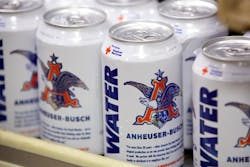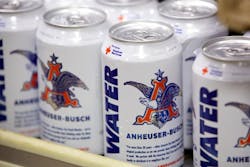Anheuser-Busch Teams with NVFC to Keep Volunteer Firefighters Hydrated
Anheuser-Busch is expanding its emergency drinking water program in partnership with the National Volunteer Fire Council (NVFC) to deliver critical hydration to volunteer firefighters across the country.
The new partnership will kick off with a donation of one million cans of clean drinking water in support of volunteer fire departments.
“As the country faces more natural disasters, like wildfires, it’s important to have more programs in place to help our emergency responders,” said Adam Warrington, vice president of corporate social responsibility at Anheuser-Busch. “With the evolution of our emergency drinking water program, we’re able to offer tangible support and necessary resources to those who are protecting our communities when they need it most.”Every year, Anheuser-Busch periodically pauses beer production to can emergency drinking water, to be ready to lend a helping hand during natural disasters and other crises. Building on this commitment, the brewer has teamed up with NVFC to deploy its brewery resources and production expertise to deliver canned water to the nation’s volunteer firefighters.
“Volunteer fire departments across the country are in need of our support,” said Heather Schafer, CEO of the NVFC. “Many Americans don’t realize that 65 percent of our nation’s firefighters are actually volunteers, with nearly 85 percent of fire departments being all or mostly volunteer. There’s plenty of support they need – but maintaining hydration during long incidents or disasters such as wildfires is a major concern for departments with limited budgets and resources. It’s been so powerful for us to team up with Anheuser-Busch in the evolution of this program to offer clean, safe drinking water to volunteer responders across the country.”
The cans of emergency drinking water will be distributed by Anheuser-Busch’s wholesaler partners in 25 markets at the start of June to help volunteer departments prepare for the upcoming wildfire season. In partnership with Anheuser-Busch, the NVFC has identified and selected the most vulnerable markets across the nation to receive the initial water donation. The program will also leverage a rapid-response approach to support volunteer departments nationwide actively fighting wildfires throughout the year.
Joining forces with Anheuser-Busch and the NVFC is the Congressional Fire Services Institute (CFSI), whose mission it is to educate members of Congress about the needs and challenges of our nation’s fire and emergency services. Together, Anheuser-Busch, the NVFC and CFSI will be raising awareness on the needs of local first responders – especially around hydration.
“Hydration is critical for firefighter performance,” said Bill Webb, president of CFSI. “Dehydration can result in decreased physical and mental performance, as well as serious health consequences – a serious concern when lives are on the line. This program is addressing a huge issue that volunteer firefighters face. Without the right resources, hydration can be a matter of life or death.”
Anheuser-Busch has a longstanding tradition of providing emergency drinking water and supplies for disaster relief efforts in partnership with the American Red Cross. Since 1988, Anheuser-Busch and their wholesaler partners have provided more than 80 million cans of water to U.S. communities affected by natural disasters nationwide.
For more information, visit anheuser-busch.com, nvfc.org or cfsi.org.
Streamlight Donates $20,000 to NFFF
Streamlight, Inc. has donated $20,000 to the National Fallen Firefighters Foundation (NFFF), including $10,000 in proceeds from sales of the company's specially marked NFFF Red Nano Light, Red Vantage helmet light, and Red Siege AA lantern. Streamlight earmarks $1, $3, and $2, respectively, from the sale of each light for the NFFF.The company also contributed $10,000 for renewal of its “Bronze Helmet” NFFF sponsorship.
Both donations will assist NFFF in commemorating the lives of firefighters who have died in the line of duty and supporting their families and co-workers.
“We are in awe of the risks that firefighters take every day to do their jobs,” said Streamlight President and Chief Executive Officer Ray Sharrah. “Streamlight is honored to continue supporting the families and surviving colleagues of fallen firefighters through our sponsorship of the National Fallen Firefighters Foundation’s programs.”
Streamlight’s sponsorship helps fund various initiatives, including the organization’s National Fallen Firefighters Memorial Weekend tribute to fallen heroes, which will be held at the National Fire Academy in Emmitsburg, MD, October 5–6, 2019. A plaque with the names of firefighters who died in the line of duty in 2018 will be added to the National Fallen Firefighters Memorial during the tribute.
Streamlight’s sponsorship support also helps fund scholarships awarded to spouses and children of fallen firefighters, and counseling programs for agencies that have lost colleagues in the line of duty.
For more information, visit streamlight.com.
NFPA to Consolidate Emergency Responder Standards
The National Fire Protection Association (NFPA) Standards Council approved a plan to consolidate the information currently contained in 114 NFPA Emergency Response and Responder Safety (ERRS) standards, guides, and recommended practices into 38 overarching standards.
The move will not only provide emergency responders with easier access to well-rounded safety information, but also improve the standards development experience for more than 2,000 principle and alternative NFPA Technical Committee Members. The five-year NFPA ERRS standards consolidation project will begin in January 2020, with 20–25 standards being combined annually, in their proper cycle. Related standards will be merged into all-inclusive standards with existing documents becoming separate chapters.
In recent years, responders and the Technical Committee members that volunteer to develop NFPA standards via a balanced consensus process, have expressed concerns about conflicts within emergency services standards; a lack of knowledge about what different Technical Committees are working on; and the inability to have representation on some committees due to the sheer number of standards. Combining applicable information into one-third of the existing standards will allow responders to access comprehensive PPE manufacturing guidance; selection, care and maintenance tips; professional qualifications benchmarks, and other critical information so that they can do their jobs more effectively.
“Over the last century, NFPA has produced more than 100 codes and standards for the benefit of the responder community,” said NFPA’s Vice President and Chief Engineer Chris Dubay. “As new threats and hazards presented, our Standards Committees came together to address different challenges and opportunities. Now is the time to take that wealth of knowledge and combine it in a way that is relevant and accessible for responders today. This undertaking blends the critical information that responders need to know to keep safe; and delivers it in a format that is more complete and convenient.”
A new revision cycle specifically for ERRS standards has been established. Both the First and Second Draft Meetings of the standards process, as well as any necessary Correlating Committee meetings, will now occur during the same year—with one meeting taking place in January and another in November. If additional meetings, such as pre-draft sessions are required, they will occur on an as-needed basis.
The consolidation announcement has been applauded by Technical Committee members who will now be able to gather in one location, allowing for more committee interaction, fewer document conflicts, and greater travel efficiencies.
For more information, visit nfpa.org.
Line-of-Duty Deaths
4 U.S. firefighters recently died in the line of duty. All four deaths were health-related. This edition of Firehouse is dedicated to these firefighters.
FIREFIGHTER JOHN LEMING, 78, of Cape May, NJ, Point Volunteer Fire Company #1, died on April 15. Leming attended a drill at the fire station and then returned home. During the night, he became ill. His wife called 9-1-1 and EMS responded. During transport to a local hospital, Leming went into cardiac arrest. Life-saving measures were unsuccessful, and he was pronounced deceased shortly after his arrival at the hospital.
FIREFIGHTER DWAIN HUDSON, 73, of the Argyle Volunteer Fire Department in Custer, SD, died on April 17. The Argyle VFD was called to an active wildland fire that was endangering structures. While responding as a passenger in the department’s compressed air foam truck, Hudson experienced a medical emergency. Firefighters and EMS personnel immediately provided emergency medical aid. He was transported to Custer Regional Hospital where resuscitation efforts continued but were unsuccessful. Hudson was pronounced deceased at the hospital.
DRIVER/ENGINEER MICHAEL WATKINS, 75, of the Northeast Lakeside Fire Department in Mountain Home, AR, died on April 24. Watkins was responding to a brush fire on April 21, when he suffered a heart attack. He was immediately taken to the hospital where he passed away a few of days later.
FIREFIGHTER /EMT BRAD GREGRICH, 30, of Desoto County Fire Rescue in Arcadia, FL, died on April 27. While on-duty at the fire station, Gregrich complained to his co-worker that he wasn’t feeling well. The next morning, returning home after his shift and still feeling ill, his wife transported him to the hospital. The hospital then released him after an evaluation. Gregrich returned home but became unresponsive and 9-1-1 was called. He was rushed back to the hospital where he suffered a major stroke and never regained consciousness. He passed away at the hospital two weeks later.








